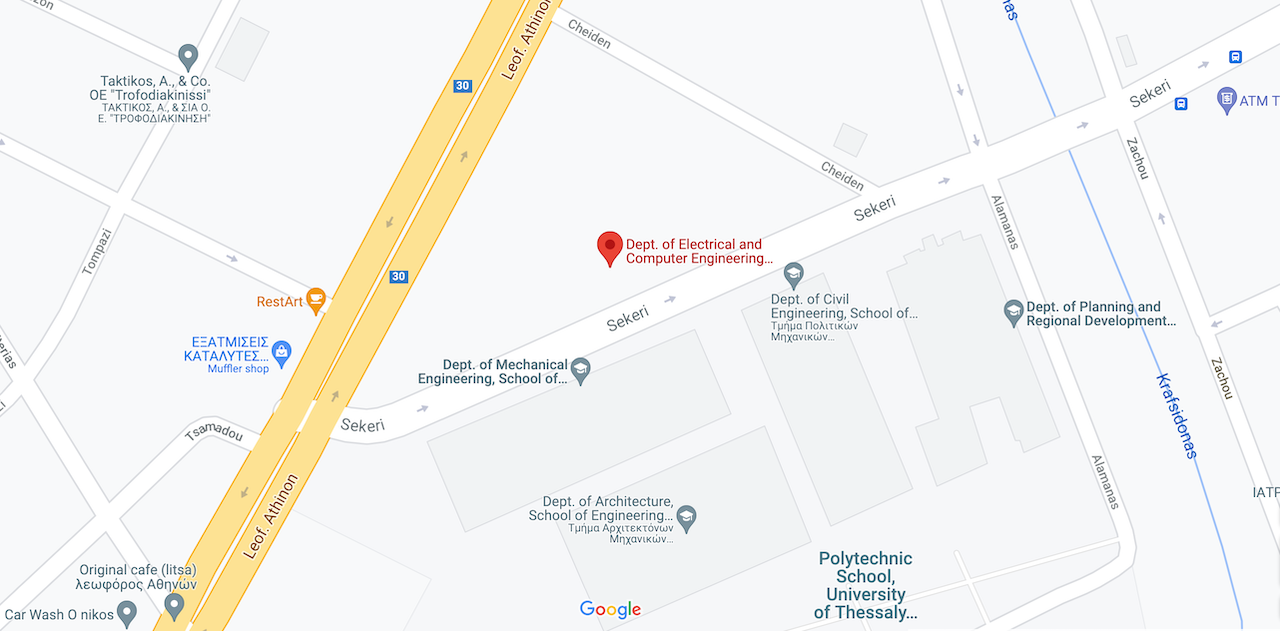| Subject Area | Energy |
|---|---|
| Semester | Semester 5 – Fall |
| Type | Elective |
| Teaching Hours | 4 |
| ECTS | 6 |
| Prerequisites |
|
| Course Site | https://eclass.uth.gr/courses/E-CE_U_309/ |
| Course Director |
|
| Course Instructor |
|
- Electric quantities, active and passive elements of direct- and alternating current. Laws of Kirchhoff, Ohm and Thevenin used for electric circuit analysis.
- Alternating current circuit quantities expressed in time- and frequency domain.
- Direct current, single- and three-phase alternating current circuits analysis.
- Magnetic circuits of direct- and alternating current machines. Magnetic behavior of ferromagnetic materials.
- Single- and three-phase power transformers. Special types of transformers. Analysisof operation, equivalent circuits, tests and measurements, applications of transformers.
- Rotating electrical machines. Basic parts of electrical machines. Creation of rotating magnetic field. Induced voltages in machine’s windings. Torque’s development, power loss and efficiency in machines.
- Direct current electrical machines. Analysis of operation of direct current motors and generators under steady state and transient (dynamic) conditions.
- Induction machines. Structural configuration of single- and three-phase induction motors. Equivalent circuits, analysis of operation under steady state and transient conditions, power flow, motor starting, torque and speed control of induction motors.
- Synchronous machines. Structure of synchronous generators (alternators) and synchronous motors. Equivalent circuits,analysis of operation under steady state and transient conditions, power flow, parallel operation of alternators and operation of a synchronous motor as a synchronous rotating condenser.
- Special types of motors, single-phase alternating current motors with commutator, Universal motors, step motors etc.
- Simulation of operation of direct- and alternating current motors by using a computer.
- Calculations concerning motor branch circuits in industrial plants. Motor supplying cables cross section calculations, sizing of motor equipment for starting, torque and speed control. Industrial motor automation circuits.
- Power electronics converters, such as inverters, rectifiers, cycloconverters and direct voltage choppers used to control direct- and alternating current machines. Simulation of electrical machines, which are controlled by power electronic converters.
This course aims to provide undergraduate students with the necessary knowledge that will enable them to understand the structure and operation principles of direct and alternating current electrical machines. Initially, the fundamental knowledge concerning the study and analysis of directand alternating current electric circuits in steady state and transient operation is presented, since this material is necessary for understanding the operation of electrical machines. Subsequently, the course focuses on the study of steady state and transient operation of the considered electrical machines under no- and full load conditions. The creation of rotating magnetic field, the power flowand efficiency, the induced voltages and torques in rotating electrical machines are described and analyzed in detail. The analysis of operation of electrical machines is carried out taking into account their equivalent electric circuits. Electronic control of direct and alternating current motors by using electric power converters are also described and analyzed. Finally, calculations concerning the dimensioning of individual parts of motor branch circuits as well as the development of motor automation circuits used in industrial plants are presented.
Upon successful completion of this course, the student will be able to:
- analyze and solve direct and alternating current circuits in steady state and transient condition,
- know the magnetic circuits of direct and alternating current electrical machines and the magnetic behavior of ferromagnetic materials,
- know and analyze the operation of single- and three phase transformers in steady state and transient operating conditions under no- and full load, the operation of rotating electrical machines, the creation of rotating magnetic field, the induced voltage and torque, the power flow and the efficiency of machines,
analyze the operation of direct current machines in steady state and in dynamic conditions, - know the structure and operating modes of asynchronous alternating current machines and analyze their operation in steady state and transient conditions through the use of equivalent circuits,
- know the structure of synchronous alternators and motorsand analyze the operation of synchronous machines in steady state and transient conditions through the use of equivalent circuits, while knows the structure and function of special types of motors, such as single phase motors with commutator, step motors, Universal motors, etc.,
- simulate the operation of direct- and alternating current machines, and calculate and size of individual equipment of motor branch circuits in industrial plants,
- understand and analyze the power electronic systems, which are used to control the direct- and alternating current electrical machines.







